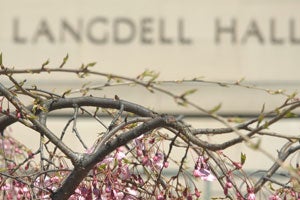This spring, two faculty members, Bruce Mann, the Carl F. Schipper, Jr. Professor of Law, and Robert Sitkoff, the John L. Gray Professor of Law, gave lectures to commemorate their appointments to endowed chairs. News coverage and video of their lectures are included below.
Professor Mann discusses revolutionary justice: law and society in the American Revolution
“Legal histories of the eighteenth century invariably stop when the Revolution begins and resume only after the Revolution has safely ended,” said Mann, who noted that no one has studied the roles law played in the daily lives of people during the war itself. “People hardly stopped trading with one another, assaulting one another or cheating one another just because there was a war going on.”
According to Mann, the war affected different parts of the country in different ways at different times and with different intensities as theaters of military action shifted from one part of the country to another. He noted that while the British occupied some cities, such as New York, Newport and Savannah, for years, other areas faced less disruption. In a talk interspersed with humor, Mann said: “Connecticut, they merely raided, burning the occasional town. New Jersey, they swept through a couple of times, although, like today, New Jersey was more a corridor than a destination.”
Mann noted that during the war law and violence were never very far apart. Recognizing this, he said, is key to understanding “the many diverse ways in which people in the Revolution tried to hold on to, refashion, and reinvent law and legal order.” Courts throughout the new states were suspended and not restored until there were new, formally constituted governments that could authorize them to resume. “Even in the middle of war and occupation,” Mann said, “Americans tried to give legal legitimacy to their actions.”
Mann discussed the provisional measures states took until civil authority could be restored—the committees of safety, which had limited judicial authority in the absence of formal courts, and, in New York, the Committees for Detecting and Defeating Conspiracies, which had subpoena power, the authority to proceed in secret if they chose to, and the authority to call out the militia to arrest “such persons whom they shall judge dangerous to the safety of the State.”
Mann also discussed the Courts of Police appointed by the British military governors of New York, which had broad civil and criminal jurisdiction and sat without juries. Ironically, loyalists disliked these courts nearly as much as they did the Committees for Detecting and Defeating Conspiracies—one ostensibly created to serve them, and the other created to root them out. In addition, he discussed the courts that eventually reopened and how their dockets reflected the progress of the war. The restoration of courts before the threat of military action subsided, Mann said, makes “a powerful statement of the commitment to civil and legal order.”
Taking the Gray chair, Sitkoff describes a revolution in trust law
In an April 29 lecture, Harvard Law School Professor Robert H. Sitkoff discussed the causes and consequences of revolutionary changes in American trust law. The talk, entitled “Lawyers, Banks, and Money: The Quiet Revolution in American Trust Law,” was part of an event honoring Sitkoff on his appointment as the John L. Gray Professor of Law.
“Rob has become already one of the preeminent scholars of trusts and estates in the country,” said Acting Dean Howell Jackson ’82 in his introduction of Sitkoff. “His work combines rigorous legal analysis and empirical grounding, his scholarship is the finest now being written in this important field, and his presence really has restored Harvard to its traditional prominence in this field.”
Sitkoff highlighted some of the key changes in the trust and estates canon. The “trinity” of trust law—revocable trusts, business trusts, and irrevocable trusts—has been transformed over the last generation, he said. Among those changes, revocable trusts have come to be recognized by the law as will substitutes, and business trusts have increasingly become codified into statutory trusts, primarily in Delaware.
The third branch of the “trinity”—the irrevocable trust—has likewise experienced significant change, Sitkoff said. Wealth today is held in liquid financial assets, not in land, and with that change came numerous implications for trust law and practice, including the rise of professional fiduciaries such as banks, and increasing jurisdictional competition among states to enact trust laws that will attract trust funds from other states.
Sitkoff went on to describe the mechanisms for the quiet revolution in modern American trust law. Some changes have been top-down, driven by elites through the Uniform Law Commission and the American Law Institute. Others have been bottom-up, driven by local bankers and lawyers, who have lobbied state legislatures for trust laws likely to attract new trust business to the state.
As an example of a top-down reform, Sitkoff pointed to the new prudent investor laws adopted in every state. He cited his empirical study showing that the new prudent investor laws resulted in widespread trust portfolio allocation by professional trustees. As an example of a bottom-up reform, Sitkoff pointed to the abolition of the Rule Against Perpetuities, and he cited another empirical study in which he showed that over $100 billion in trust funds has poured into the abolishing states.
Sitkoff concluded by looking towards the future of trusts and estate law. Among other things, he suggested that the increasing codification of American trust law has resulted in the state legislatures supplanting the courts as the “superintendent of trust and estate law,” with responsibility for continued doctrinal maintenance.
